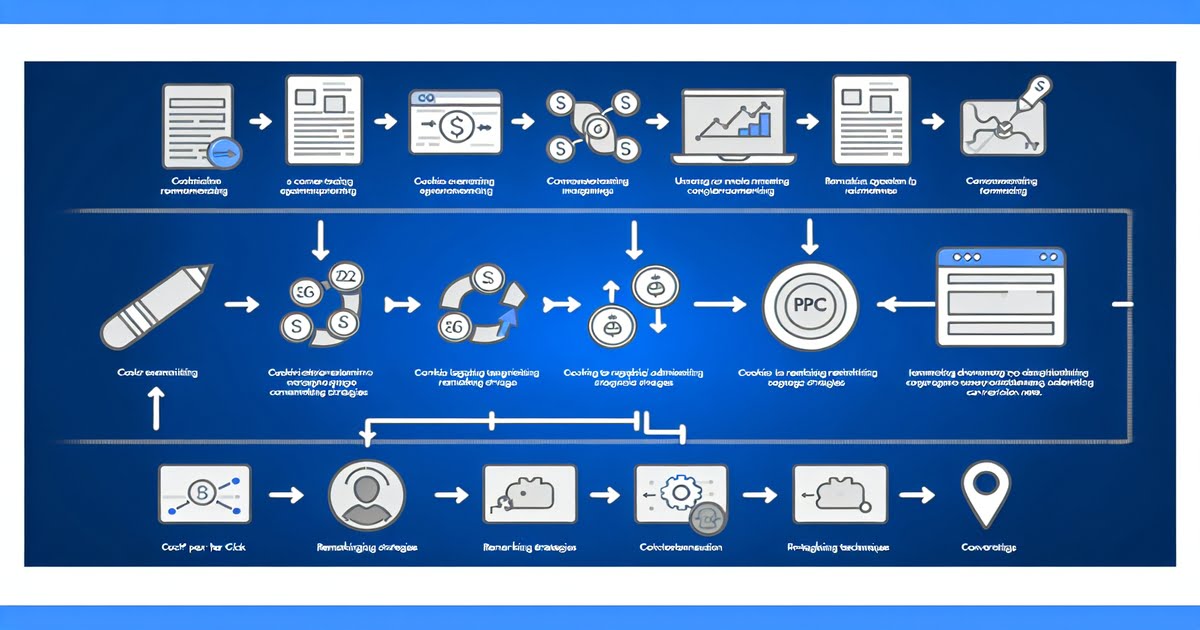Ever wondered why some brands seem to follow you around the internet, reminding you of products you’ve glanced at but never bought? That’s remarketing strategies in PPC working their magic. These clever tactics aren’t just about keeping products in your line of sight; they’re about creating a personalized shopping experience that feels almost bespoke. From understanding your audience to tailoring ads that speak directly to them, remarketing is an art form that blends psychology with technology. In this dive into the world of PPC remarketing, we’ll uncover how these strategies not only boost sales but also build deeper connections with customers. Ready to see how it’s done? Let’s peel back the curtain on this digital marketing marvel.
Key Takeaways
- Remarketing is a powerful tool in PPC that allows you to re-engage with users who have previously interacted with your website or app, making it crucial to understand its fundamentals for effective campaign management.
- Setting clear, measurable goals at the outset of your remarketing campaign is essential for guiding strategy and evaluating success.
- Crafting tailored remarketing lists based on user behavior and interaction history can significantly increase the relevance and effectiveness of your campaigns.
- Choosing the right platforms for your remarketing efforts is key to reaching your target audience where they are most active and engaged.
- Audience targeting and segmentation enable you to deliver personalized ad experiences, improving campaign performance and ROI.
- Continuous performance optimization, through regular review of analytics and adjustment of creative elements, bidding strategies, and targeting, is critical to staying ahead in a competitive landscape.
Understanding Remarketing
PPC Basics
PPC, or Pay-Per-Click, is a model of internet marketing. Advertisers pay a fee each time one of their ads is clicked. It’s essentially buying visits to your site.
Keyword research is vital in PPC. The right keywords connect you to the desired audience. They make your campaign effective.
Cost-per-click (CPC) matters too. It affects how much you spend on ads. A lower CPC means more clicks for your budget.
Remarketing Essentials
Remarketing aims to reconnect with past website visitors. It’s about bringing them back.
Cookies track user behavior online. They help in targeting the right audience for remarketing campaigns.
To start remarketing, you create a list based on user actions on your site. For example:
- Visited specific pages
- Added items to cart but didn’t buy
- Spent a certain amount of time on the site
Analytics Integration
Linking PPC campaigns with analytics tools is crucial. It lets you see what works and what doesn’t. This way, you can improve future campaigns.
Data analysis enhances performance significantly. You learn from past actions and adjust strategies accordingly.
Key metrics include:
- Click-through rate (CTR)
- Conversion rate
- Return on ad spend (ROAS)
Tracking these helps measure success in remarketing efforts.
Setting Campaign Goals
Brand Awareness
Remarketing strategies in PPC shine. They keep your brand visible to those who’ve already shown interest. This constant visibility helps your brand stay on the audience’s mind.
By using targeted ads, you can ensure that past visitors remember your brand. These ads appear while they browse other sites or use social media, keeping your brand front and center. It’s like a gentle reminder of what they’ve seen before.
Measuring the impact on brand awareness is crucial. Look at engagement rates for these insights. High engagement means people not only recall your brand but also interact with it positively.
Increased Conversions
Remarketing is powerful for nudging users closer to making a purchase. Tailoring messages specifically for them makes this possible.
These personalized messages guide users through the conversion funnel effectively. For instance, someone who left a cart full could get an ad reminding them of what they’re missing out on. Personalized offers are key here too. Offering something unique based on their browsing behavior can significantly boost conversions.
Let’s talk about conversion rate optimization (CRO) in remarketing next. Using CRO strategies helps fine-tune remarketing efforts for better results. Test different ad elements like copy or visuals to see what converts best.
ROI Measurement
Calculating ROI from PPC campaigns tells if you’re getting value from your investment. It involves tracking how much you spend versus how much you earn from conversions and sales.
To measure accurately, track all conversions and sales resulting from remarketed ads. This data gives clear insight into whether remarketing adds value or not.
Comparing pre- and post-remarketing campaign ROI is enlightening. It shows exactly how much impact remarketing has had on overall performance.
Crafting Remarketing Lists
Engaged Users
Targeting users who have already shown interest in your site is a smart move. Focus on those who spent time on specific pages. This approach ensures you’re reaching out to people more likely to engage further.
Creating content that resonates with these audiences is key. It should reflect their interests based on the pages they visited. Measure engagement through click-through rates (CTR). High CTR indicates your content hits the mark.
Video Campaigns
Video content can significantly boost engagement in remarketing ads. Platforms like YouTube offer excellent opportunities for video remarketing. They allow you to connect with viewers in a dynamic way.
The importance of video view metrics cannot be overstated. These metrics help gauge the success of your campaigns and guide adjustments for better performance.
First-Party Data
Using website data, you can create precise targeting segments for your campaigns. This strategy involves utilizing information directly collected from your audience.
Remember, when using first-party data, staying compliant with privacy laws is crucial. Integrating CRM data provides deeper insights into your audience’s preferences and behavior patterns.
Platform Choices
Google Ads
Google Ads is a powerhouse for remarketing campaigns. It lets you re-engage with people who visited your site. You can easily set up these campaigns within the platform.
The Google Display Network offers a broad reach. Your ads can appear on numerous sites across the internet. This increases the chances of reconnecting with your audience.
Dynamic remarketing takes it a step further. It customizes ad experiences based on what visitors viewed on your site. For instance, if someone looked at shoes but didn’t buy, they’ll see ads for those shoes later.
Bing Ads
Bing presents unique remarketing opportunities thanks to its distinct audience. Not everyone uses Google, and tapping into Bing’s users can be beneficial.
To start remarketing on Bing, you need Universal Event Tracking (UET) tags. These tags track visitor behavior on your website which is crucial for effective remarketing.
It’s wise to compare performance between Bing and Google efforts in remarketing strategies in PPC. Each platform has its strengths and weaknesses depending on your target audience and goals.
Cross-Platform Strategies
Combining platforms enhances coverage significantly in remarketing strategies in PPC.
- Use both Google and Bing along with social media platforms.
- This approach ensures that no potential customer slips through the cracks regardless of their preferred platform or device.
Cross-device targeting capabilities are critical here.
- People switch devices often.
- Ensuring that your message reaches them consistently across all devices improves campaign effectiveness.
Consistent messaging across platforms cannot be overstated.
- If someone sees one message on Facebook and an entirely different one on Google, it confuses them.
- Keeping messages aligned builds trust and reinforces brand recall.
Audience Targeting and Segmentation
Choosing Audiences
Audience targeting is a cornerstone of effective remarketing strategies in PPC. It starts with segmenting audiences based on their behavior and demographics. This allows for more personalized ad experiences.
You can pinpoint users who have shown high intent but haven’t converted yet. These users are prime targets for direct remarketing efforts. They’ve already expressed interest, making them more likely to engage further.
On the flip side, it makes sense to exclude previous converters from certain campaigns. Focus resources on capturing new opportunities rather than preaching to the choir.
Segmenting for Efficiency
Efficiency in remarketing comes down to how well you know your audience segments. Break down your audience lists by specific criteria like product interest or pages visited.
For each segment, tailor your ad copy and offers to match their interests and behaviors. This customization increases relevance, which boosts engagement rates.
Separately analyze the performance of each segment. This lets you make data-driven decisions about where to allocate budget for maximum impact.
Excluding Low-Quality Traffic
Not all traffic is good traffic. Identifying visitors with low engagement helps refine your focus on quality leads.
Use metrics like bounce rate and session duration as clues for exclusion criteria. High bounce rates often signal disinterest or a mismatch between the user’s expectations and what they found.
Creative Ad Development
Compelling Creatives
Designing eye-catching visuals and persuasive copy is crucial. Ads must grab attention quickly. Use vibrant colors, bold fonts, or unique layouts to stand out.
Testing different formats can reveal what your audience prefers. Try static images for simplicity, animated gifs for engagement, or interactive ads for involvement. Each has its place depending on the campaign’s goal and the platform it’s displayed on.
Your creatives should always reflect your brand identity. They should also align with specific campaign goals to ensure consistency across all marketing efforts. This harmony boosts brand recognition and trust among viewers.
Offers and Timelines
Creating urgency in your ads can significantly boost conversions. Limited-time offers encourage users to act fast rather than delay their decision-making process.
Personalizing offers makes them more appealing. If a user has been browsing certain products but hasn’t made a purchase, showing an ad with those products at a discount can be very effective.
Scheduling ads based on user activity patterns increases visibility when they’re most likely online and engaged. Analyzing data from previous interactions helps determine these optimal times, making your remarketing strategies in PPC more efficient.
Post-Purchase Strategies
After someone buys something from you doesn’t mean the interaction should end there. Suggesting complementary products through remarketed messages keeps the conversation going and increases customer lifetime value.
Implement loyalty programs within your remarketing strategies in PPC to encourage repeat purchases. Offer points or rewards that customers can redeem through future purchases as an incentive for them to keep coming back.
Gathering feedback is another way to engage customers post-purchase. Distribute surveys via remarketed messages asking about their shopping experience. This not only provides valuable insights but also shows that you value their opinion.
Bidding and Budgeting Strategies
Bidding for Conversions
Bidding smartly is key in remarketing strategies for PPC. You should adjust your bids based on how likely someone is to convert. This means putting more money behind users who have shown a strong interest in your product or service. Automated bidding can help here. It adjusts your bids in real time, aiming to get the most conversions.
Regular monitoring of these adjustments ensures you’re always optimizing for the best results. Let’s say you notice a particular ad set converting well at certain times of the day; you might increase your bid during those hours to capitalize on that trend.
Budget Efficiency
Managing your budget efficiently is crucial. Start by allocating more funds to campaigns showing good performance and potential return on investment (ROI). This approach ensures that every dollar spent has the chance to contribute significantly towards achieving your business goals.
CPA targeting can be a game-changer here by controlling spending based on acquisition costs rather than clicks or impressions. If one campaign isn’t performing as expected, don’t hesitate to shift its budget towards those that are succeeding. This dynamic reallocation keeps your overall strategy agile and responsive.
Testing Conversion Value
After developing creative ads, testing their conversion value becomes essential. Different call-to-actions (CTAs) can lead to varied outcomes, so experimenting with them helps identify what works best with your audience. Tracking which landing pages yield higher conversions also provides insights into user preferences and behavior.
Split testing compares different elements of your campaigns directly against each other, offering clear data on what maximizes conversion value. Whether it’s changing a headline or tweaking an image, small changes can sometimes lead to significant improvements in performance.
Performance Optimization
KPI Monitoring
After setting up your remarketing strategies in PPC, it’s crucial to monitor their performance. Key Performance Indicators (KPIs) are your guideposts. They tell you if you’re on the right path towards achieving your campaign goals. For remarketing campaigns, important KPIs include click-through rate (CTR), conversion rate, and cost per conversion.
You should review these KPIs regularly. This helps you understand how well your ads resonate with your audience. If a particular ad has a low CTR, it might not be engaging enough. Or if the cost per conversion is high, maybe the ad isn’t reaching the right people.
Adjusting strategies based on these trends is essential for improvement. Let’s say an ad shows an increasing trend in conversions over time; this could indicate that its message aligns well with what users want to see more of.
A/B Testing
A/B testing plays a pivotal role in optimizing remarketing campaigns. It involves comparing two versions of an ad or landing page to see which one performs better.
For instance, you might test two different headlines or images in your ads to see which garners more clicks or leads to more conversions. Changing just one element at a time ensures clarity about what influences performance changes.
The results from A/B tests can significantly inform future campaign adjustments by highlighting effective elements worth replicating across other ads or pages.
Consider testing variations in calls-to-action (CTAs) too; sometimes a slight change in wording can lead to substantial improvements in user engagement and conversions.
Integration with Marketing Channels
To maximize effectiveness, integrate PPC campaigns with other marketing efforts like email marketing and social media.
Syncing PPC campaigns with email marketing ensures cohesive messaging across platforms. For example, someone who clicked on one of your PPC ads but didn’t convert could receive an email reinforcing the value proposition seen in the ad.
Leveraging social media insights for targeted remarketing is another powerful strategy—use data from social interactions to refine targeting criteria for PPC campaigns.
Coordinating campaign timing across channels maximizes impact by ensuring consistent messaging when users are most receptive across different platforms.
Advanced Remarketing Tactics
Top-of-Funnel Strategies
Attracting a broad audience starts with general interest content. This type of content doesn’t push for a sale. Instead, it aims to grab attention and spark curiosity. Think of ads that tell a story or present an intriguing idea related to your brand. They’re not selling anything yet, just introducing themselves.
Engaging storytelling in ads is crucial here. Stories can capture the imagination and make people want to learn more about your brand or product without feeling pressured. The goal is to pique interest so that when they see more targeted ads later, they’ll remember your initial message.
Focusing on brand introduction rather than immediate conversion is key at this stage. You’re laying the groundwork for future interactions by making potential customers aware of who you are and what you stand for, rather than pushing them towards an instant purchase.
Consideration Stage Tactics
Once you’ve caught their attention, it’s time to provide detailed information about your products or services. Here’s where you get into specifics about what makes your offering unique and why they should choose it over others.
Highlighting USPs (Unique Selling Points) and customer testimonials can significantly impact decision-making processes for potential buyers who are still on the fence. Knowing what sets you apart from competitors or hearing positive feedback from other customers builds trust.
Target users who have shown specific interest but haven’t converted yet by tailoring messages directly to their needs or concerns based on their previous interactions with your site or ads.
Cross-Promotion Based on Behavior
Recommending related products based on browsing behavior takes personalization up a notch by showing users items that complement what they’ve already looked at or purchased before.
Cross-selling items frequently bought together not only increases the value of each purchase but also enhances user experience by suggesting relevant additions they might not have considered otherwise.
Using past purchase data to predict future buying interests allows for even more personalized marketing efforts, potentially uncovering new opportunities for engagement and sales among returning customers.
Summary
Diving into the world of PPC remarketing is like unlocking a treasure chest of opportunities to reel back those almost-customers. You’ve got the map—understanding the basics, setting goals, building those crucial lists, picking the right platforms, and targeting like a pro. Not to mention, crafting ads that stick, strategizing your bids and budgets, and constantly tuning for peak performance. It’s all about keeping your eyes on the prize and adjusting your sails as you go. Advanced tactics? They’re your secret weapons to outsmart the competition and keep your audience hooked.
Now’s the time to take these insights and run with them. Think of your campaign as a garden. You’ve planted the seeds with smart remarketing strategies; watering them means testing, optimizing, and staying creative. Ready to watch your garden bloom? Roll up your sleeves, because those clicks won’t wait around forever. Let’s make those browsers into buyers, shall we?
Frequently Asked Questions
What is remarketing in PPC?
Remarketing lets you show ads to people who’ve visited your website before. It’s like saying “Hey, remember us?” but through targeted ads across the web.
How do I set goals for a remarketing campaign?
Think about what you want to achieve – more sales, sign-ups, or brand awareness? Setting clear goals helps steer your campaign in the right direction from the get-go.
Can you explain crafting remarketing lists?
Crafting remarketing lists involves grouping past visitors based on their actions on your site. Imagine sorting your friends based on their favorite ice cream flavors; it’s somewhat similar, but with website behavior.
Why does platform choice matter in remarketing?
Different platforms reach different audiences. It’s like choosing between emailing or texting someone based on which one they check more often. You want to pick where your audience hangs out most.
How important is audience targeting and segmentation?
Super important! It’s like tailoring a suit – it needs to fit perfectly. Segmenting ensures that the right message reaches the right person at the right time.
What should I consider when developing creative ads for remarketing?
Keep them relevant and engaging. Think of it as making a personalized invitation card for each guest attending your party; cater to their interests and preferences.
Any tips on bidding and budgeting strategies for remarketting campaigns
Start with understanding how much a conversion is worth to you then adjust bids according to segments’ performance. Think of it as investing more in winning horses during a race.









